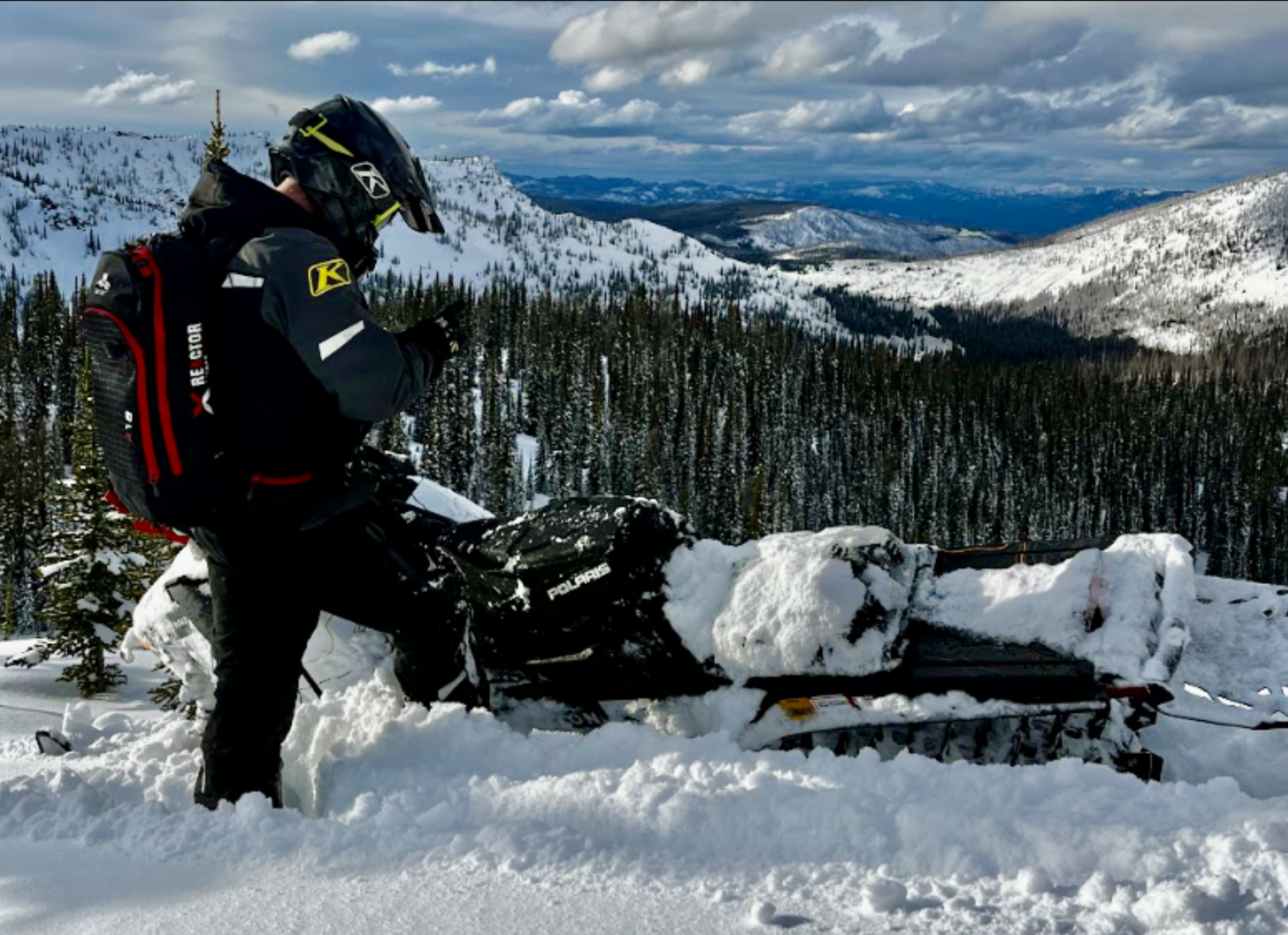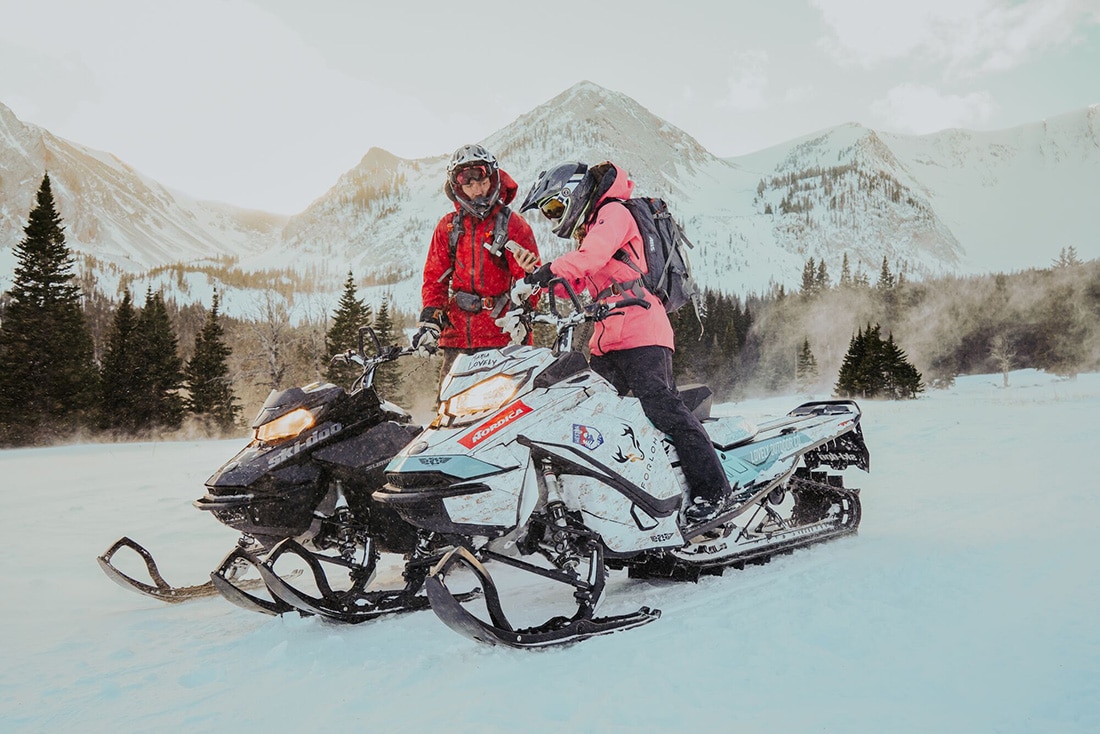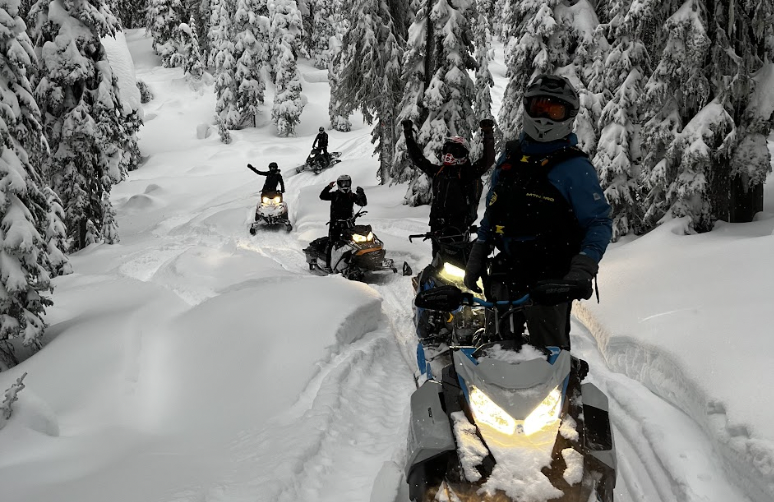Snowmobiling For Beginners
Snowmobiling for beginners can be an exciting winter activity. For those unfamiliar with riding a snowmobile, the task sounds daunting but it’s really not that bad. We’re going to break down some tips and tricks to help you and your friends have some fun out in the snow. Who knows, with a little practice, you might get addicted to the sport. There are few off-road vehicles that can open up winter as well as snowmobiles can.
Things to Know About the Sled

A reliable sled is a must while out in the backcountry during winter months. A situation can go bad fast with the varying weather conditions winter can throw at you. The sled will also dictate whether you’re hitting the steeps or rippin’ the trails. Some things to consider when choosing a sled are:
1. Mountain Sleds vs. Trail Sleds
It all depends on what adventure you’re looking for and you can find sled best-suited for big mountain powder or groomed trails. When you hear the words “mountain snowmobile” don’t let that fool you, you can ride them just fine on trails—it just won’t be as comfortable as a true trail machine. On the flip side, if you know you’ll be riding trails and trails only, you’ll be more comfortable on a purpose-built machine.
Mountain sleds are more capable and can get you just about anywhere—they also can get you into more trouble. You can quickly find yourself miles away from the trail, handlebar-deep in powder. If you do decide to go this route as a beginner, make sure you have some friends with you and we recommend having at least some sort of experience with a throttle.
Trail sleds are a great option if you’re looking to stick to the trails and take in the scenery. Trail sleds have larger intercoolers and shorter tracks, which allow them to stay cool even on hard groomed trails. They also tend to be more comfortable with big plush seats and sometimes a back support. If you are brand new to snowmobiling, we recommend going the trail sled route and sticking to the groomed trails to start.
2. See What Tools are Needed
Most new sleds come with a factory tool kit of some sort, but they’re usually lacking a lot. For the basics, have a spare belt, a tool to get the belt off (some sleds require an open wrench and some require an allen), and spare plugs, especially in older carbureted two-stroke sleds because they tend to foul more often.
Do your homework on what your sled has most of in terms of nuts and bolts. Most sleds will only differ between three to five sizes for tools. Usually, an 8mm-14mm wrench set can handle a lot of backcountry repairs since you can only do so much without spare parts.
3. Repairing a Snowmobile
If you snowmobile enough, you’ll be amazed how you quickly learn to “MacGyver” stuff. Sleds are getting lighter and lighter and that can come at the cost of weaker parts. We can’t count how many times A-arms have snapped way out in the backcountry and you have to get creative to get the sled out. We’ve tied logs, stolen parts from somewhere else on the sled, tied them up with rope—you name it, we’ve done it.
Breaking an A-arm is probably the most common break and after some trial and error, having the thick ⅜ zip ties and NRS-type straps (where you can loop them back on themselves) are a game changer. They can also be used for other breaks and we recommend having some in your tunnel bag or backpack.
Always know where youy are at
Get the onX Offroad app and feel confident knowing where you are while riding or in case of emergency.
How to Ride a Snowmobile
All sleds are equipped with a thumb throttle, left-hand brake, and an emergency brake. Working knowledge of these elements is the only way you’ll be able to ride. We’re not going to tell you how to ride a snowmobile here—there’s a lot to them and your experience can vary greatly. On the safety side of things, most sleds will be equipped with a tether that you’ll want to attach in case you fall off your sled.
Other noteworthy mentions are knowing how to restart your sled. This may seem obvious, but if you find yourself struggling to get your snowmobile started, you’ll often find a switch or key turned off and nothing happens. If you’re renting, ask the guide before you leave the shop. The last thing to make sure you know how to do is properly work your heated grips—freezing hands can make or break your experience.
What to Wear Snowmobiling
There are many factors to consider when choosing your gear, and getting this wrong can turn a day upside down. Dry and cold climates are going to be different than wetter, warmer climates so educate yourself on the area you are going to be riding in. (You can also call local shops and ask). Just remember, it’s better to have and not need a piece of gear then to need some and not have it with you.
- Waterproof and insulated gear can make all the difference in the world. The old saying “the weather isn’t bad, it’s just bad gear” is very true while on a sled.
- Full face helmet and good goggles (with some sort of darker tint for the bright snow). Also have a way to clean or wipe lenses off.
- Good gloves (and spare) with dexterity. 90% of sleds on the trails today have hand warmers, so a good pair of gloves that are on the thinner side where you can work the throttle and brake is key. Most people who are new to sledding think of putting on the warmest gloves they can find and will struggle to work the throttle and will find their hands cramp way faster.
- Extra outer waterproof shell. If your gear is soaking wet, you can at least pull a quick rain jacket over to help keep you dry and double as a windbreaker.
- Some sort of wool as your first layer.
- Boots are also a crucial part of the gear list. You want something waterproof, warm, and supportive. Snowmobiles have sharp edges where your feet go (the tunnel) and boots will take a beating. If you don’t have specific snowmobiling boots, a pair of Sorels (or something similar) will work.
- Safety gear.We’re not going to tell you that you have to wear knee pads or a chest protector, but just consider the dangers of going fast across the hard pack snow. You never know, a simple piece of plastic could save your life. If a rental shop already provides them, why not wear it?

Avalanche Safety Gear
Especially out West in the high mountains, avalanches are part of backcountry snowmobiling. Make sure you’re monitoring snow conditions, reading avy reports, and most importantly, using your best judgment. The best way to avoid slides is to notice the signs before they happen. On days where snow is unstable, there’s nothing wrong with staying lower and having fun in the trees and being on less aggressive terrain. Keep in mind onX Offroad has all of the necessary tools and features right in the App with Avalanche Forecast, Slope Angle, SNOTEL sites, and more.
If you find yourself getting into the steep country quite a bit, then we recommend an avalanche backpack with float technology. Inside that bag, have a shovel and probe and know how to use them. Most people just buy the stuff and never take it out of the bag—make sure to practice getting your equipment out in an efficient manner in case of a burial.
Get yourself an avalanche beacon and know how to properly use it. There are plenty of ways nowadays to get trained on how to use your beacon. From YouTube to classes to taking a formal multi-day course, there’s no excuse for not knowing how to use your beacon. Also, use fresh batteries every year and practice in safe areas to keep your skills up. For those sticking to the lowlands and rippin’ trails, you won’t have to worry about slides as much but we still recommend having a beacon just in case.
Other Essential Gear for Snowmobilers
This section is going to cover the basics for what we have found to be “a must” while out on our snowmobiles. This is by no means the “best” kit, but it covers some basics. Note that there are some key items that will be wrapped into this list that we covered above.
- Foldable saw to cut your way out if you find yourself pinned against a tree (especially facing downhill).
- Siphon for bumming fuel.
- Make sure you can build a fire. We’re not going to cover the many different ways to achieve that, but just remember you can use your siphon to trickle out a bit of fuel onto something to light if you’re really in a pinch.
- Glow sticks, strobes, or any other light. If something goes really wrong and SAR is out to get you, having something to mark your location either from the sky or the ground is a must.
- Good radios. Radios are arguably the most important tools out there. Not only for constant communication for navigational purposes, but for safety. We’ve had sleds pin buddies down, roll over on top of them, or break down, and the radio is what saved the day.
- Water, water, water.
- Medical supplies. This list can go on and on and we’re not medical professionals telling you what your med bag needs to have in it but some of the most common medical supplies are arm splints, tape, and slings.
- The most important safety of all is to never go out alone and have at least one buddy with you with another sled.

Best Places for Beginner Snowmobiling
If you’re looking for riding fresh groomed trails, states like Wisconsin and Michigan are great options. If you’re looking for more mountainous places, Colorado has some world-class snowmobiling. You can also find some amazing spots for snowmobiling in national parks. Luckily for those new to the sport, there are thousands of places to learn how to ride a snowmobile and it really depends on where you live and how far you are willing to travel to ride.
In general, “Out West” you can find snowmobile terrain just about anywhere. But you also need to stay legal. The onX Offroad App tells you where you can and cannot ride by knowing what type of land you’re riding on, which is incredibly helpful for planning a trip or seeing where to go next.
There is no single best place to ride, we just recommend following the weather windows and let that be the main driver to different locations. Another factor to make your decision is snowmobile rental availability. With the growing popularity of the sport, most rental places are almost always completely booked. So, do you research and call ahead to line up a snowmobile or two.
Research Local Laws and Rules of the Trail
As mentioned above, there are too many places to ride to narrow them all down but, the main thing is knowing where you can and can’t ride. It’s very important to know where the boundary lines are because a trail can act as an easement and the trail actually allows you to cross legally but you have to remain on the trail until you’re back on public land. As far as rules of the trail go, there are a mix of common-sense informal rules and state-mandated formal ones. Here’s a combo:
- Stay to the right of the trail (just like driving a car), especially around blind corners. You don’t have to worry about signals, and snowmobiles are equipped with headlights and brake/tail lights.
- When passing other riders, know how many riders are behind you and let them know. Example: You are leading the ride and have three riders behind you. A group that’s oncoming passes you and you’ll usually see the other riders hold up fingers. What does that mean? That’s letting you know they have (X amount of fingers they held up) riders still behind them so use extreme caution. Your job is to hold up three fingers to let the other riders know you have three more behind you.
- This one is not really written anywhere, it’s just something you should be aware of: stay somewhat steady on the throttle.
Nothing will make you want to get off a snowmobile faster than riding super chopped out trails that are almost like ski moguls. You’ll be riding on a nice and smooth trail and all the sudden, it gets rough. The reason for this is people “blipping the throttle” and slowly creating “whoops.” This often happens entering and exiting corners because instead of staying steady around the whole corner, people will go super fast, slam on the brakes, and then accelerate out of the corner. This will create rough riding conditions and we promise, you will not enjoy riding those mogul-style ruts. Of course you alone can’t prevent these speed bumps from happening—just be aware of what causes them. - All states require riding with registration. If you’re going the rental route, the shops (usually) will have all the necessary information on the snowmobile. If you borrow a snowmobile from a buddy and take it across state lines, make sure you have a Trail Pass (some states call it something else) and registration on you. Some states like Washington, Oregon, and California will also require an additional step by purchasing tags every year (just like a car) so keep that in mind.
Begin Snowmobiling with confidence
The onX Offroad app has offline maps, public and private land information, customizable markups and so much more.
Snowmobiling on trails with a trail snowmobile is very easy to learn if you have basic basic understanding on working a thumb throttle and brakes. Snowmobiling in the steep country with a mountain sled is not easy.
As soon as you get your first snowmobile stuck off trail in powder, you will quickly see how physically demanding it is. If you’re riding along a trail, it’s not that bad. Just like with everything else, the more you advance, the farther and longer you ride, and the more physically demanding riding becomes.
- If you’re someone who wants to dive in head first and either ride mountainous terrain or aspire to, we recommend not wasting your time and money on a trail snowmobile. Yes, mountain sleds are harder to ride but it’s better to struggle on a more capable machine at first and then grow into it. Sleds aren’t just like a pair of skis you can upgrade every year (at least for most of us) so make your purchase count.
We’re not going to cover every make, model, and best years, that’s for you to research. All manufacturers have a different “feel” to them and it’s hard to explain. The most important thing, especially if you’re buying used, is to use your best judgment on how the machine was treated and know that sleds absolutely have a “shelf life.”